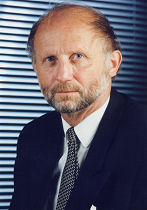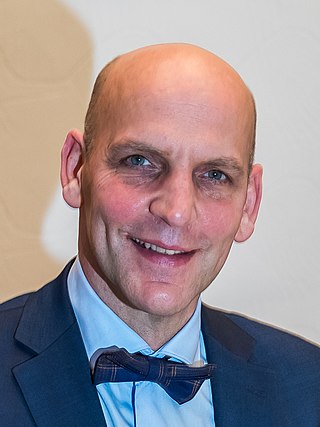
In chemistry, a polyoxometalate is a polyatomic ion, usually an anion, that consists of three or more transition metal oxyanions linked together by shared oxygen atoms to form closed 3-dimensional frameworks. The metal atoms are usually group 6 or less commonly group 5 and group 7 transition metals in their high oxidation states. Polyoxometalates are often colorless, orange or red diamagnetic anions. Two broad families are recognized, isopolymetalates, composed of only one kind of metal and oxide, and heteropolymetalates, composed of one or more metals, oxide, and eventually a main group oxyanion. Many exceptions to these general statements exist.

Benzothiophene is an aromatic organic compound with a molecular formula C8H6S and an odor similar to naphthalene (mothballs). It occurs naturally as a constituent of petroleum-related deposits such as lignite tar. Benzothiophene has no household use. In addition to benzo[b]thiophene, a second isomer is known: benzo[c]thiophene.

Achim Müller was a German chemist. He was Professor Emeritus at the Faculty of Chemistry, University of Bielefeld.
Alexander C. Filippou has been a Professor of Inorganic Chemistry at the Rheinische-Friedrich-Wilhelms-University Bonn since 2005.
The Tsuji–Trost reaction is a palladium-catalysed substitution reaction involving a substrate that contains a leaving group in an allylic position. The palladium catalyst first coordinates with the allyl group and then undergoes oxidative addition, forming the π-allyl complex. This allyl complex can then be attacked by a nucleophile, resulting in the substituted product.
Michael Pope, was born and educated in England. He received B.A. and D.Phil. degrees from Oxford University. He can be considered as one of the leading and most influential polyoxometalate chemists worldwide. His 1983 book entitled “Heteropoly and Isopoly Oxometalates” is the most cited reference in the field.
Corinna S. Schindler is a Professor of Chemistry at the University of Michigan. She develops catalytic reactions with environmentally benign metals such as iron, towards the synthesis of biologically active small molecules. For her research in the development of new catalysts, Schindler has been honored with several early-career researcher awards including the David and Lucile Packard Foundation Fellowship in 2016, the Alfred P. Sloan Fellowship in 2017, and being named a member of the C&EN Talented 12 in 2017. Schindler has served on the Editorial Board of Organic and Bimolecular Chemistry since 2018.
Richard Dronskowski is a German chemist and physicist. He is a full professor at the RWTH Aachen University.

Helma B. Wennemers is a German organic chemist. She is a professor of organic chemistry at the Swiss Federal Institute of Technology in Zurich.
Paul Knochel is a French chemist and a member of the French Academy of Sciences.
Tomislav Friščić holds the Leverhulme International Professorship and Chair in Green and Sustainable chemistry at the University of Birmingham. His research focus is at the interface of green chemistry and materials science, developing solvent-free chemistry and mechanochemistry for the cleaner, efficient synthesis of molecules and materials, including organic solids such as pharmaceutical cocrystals, coordination polymers and Metal-Organic Frameworks (MOFs), and a wide range of organic targets such as active pharmaceutical ingredients. He is a Fellow of the Royal Society of Chemistry (RSC), member of the College of New Scholars, Artists and Scientists of the Royal Society of Canada and a corresponding member of the Croatian Academy of Sciences and Arts. He has served on the Editorial Board of CrystEngComm, the Early Career Board of the ACS journal ACS Sustainable Chemistry & Engineering, and was an Associate Editor for the journal Molecular Crystals & Liquid Crystals as well as for the journal Synthesis. He was a Topic Editor and Social Media Editor, and is currently a member of the Editorial Advisory Board of the journal Crystal Growth & Design published by the American Chemical Society (ACS). He famously has a dog named Zizi.
An oxyhydride is a mixed anion compound containing both oxide O2− and hydride ions H−. These compounds may be unexpected as the hydrogen and oxygen could be expected to react to form water. But if the metals making up the cations are electropositive enough, and the conditions are reducing enough, solid materials can be made that combine hydrogen and oxygen in the negative ion role.
Ellen Sletten is an American chemist who is the John McTague Career Development Chair at University of California, Los Angeles. Her research considers the use of physical organic chemistry for diagnostics and medical therapies.
The borosulfates are heteropoly anion compounds which have sulfate groups attached to boron atoms. Other possible terms are sulfatoborates or boron-sulfur oxides. The ratio of sulfate to borate reflects the degree of condensation. With [B(SO4)4]5- there is no condensation, each ion stands alone. In [B(SO4)3]3- the anions are linked into a chain, a chain of loops, or as [B2(SO4)6]6− in a cycle. Finally in [B(SO4)2]− the sulfate and borate tetrahedra are all linked into a two or three-dimensional network. These arrangements of oxygen around boron and sulfur can have forms resembling silicates. The first borosulfate to be discovered was K5[B(SO4)4] in 2012 by the research group of Henning Höppe, although the compound class as such had been postulated already in 1962 by G. Schott and H. U. Kibbel. Over 80 unique compounds are known as of 2024.

Regina Palkovits is a German chemist who is a Professor of Chemistry at the RWTH Aachen University. Her research considers heterogenous catalysis. She was elected a Fellow of the North Rhine-Westphalian Academy of Sciences, Humanities and the Arts in 2020. In 2023 she was appointed as Director at the Institute for a Sustainable Hydrogen Economy (INW) at Forschungszentrum Jülich.
A nitridophosphate is an inorganic compound that contains nitrogen bound to a phosphorus atom, considered as replacing oxygen in a phosphate.

Benjamin List is a German chemist who is one of the directors of the Max Planck Institute for Coal Research and professor of organic chemistry at the University of Cologne. He co-developed organocatalysis, a method of accelerating chemical reactions and making them more efficient. He shared the 2021 Nobel Prize in Chemistry with David MacMillan "for the development of asymmetric organocatalysis".
René Peters is a German chemist and since 2008 Professor of Organic Chemistry at the University of Stuttgart.
Sigma non-innocence is a special form of non-innocence, an oxidation characteristic in metal complexes. It is mainly discussed in coordination complexes of late transition metals in their high formal oxidation states. Complexes exhibiting sigma non-innocence differ from classical Werner coordination complexes in that their bonding and antibonding orbitals have an inverted distribution of metal and ligand character. The oxidation of the ligand and a lowered charge at the metal center renders the assignment of the oxidation state non-trivial.
A ketenyl anion contains a C=C=O allene-like functional group, similar to ketene, with a negative charge on either terminal carbon or oxygen atom, forming resonance structures by moving a lone pair of electrons on C-C-O bond. Ketenes have been sources for many organic compounds with its reactivity despite a challenge to isolate them as crystal. Precedent method to obtain this product has been at gas phase or at reactive intermediate, and synthesis of ketene is used be done in extreme conditions. Recently found stabilized ketenyl anions become easier to prepare compared to precedent synthetic procedure. A major feature about stabilized ketene is that it can be prepared from carbon monoxide (CO) reacting with main-group starting materials such as ylides, silylene, and phosphinidene to synthesize and isolate for further steps. As CO becomes a more common carbon source for various type of synthesis, this recent finding about stabilizing ketene with main-group elements opens a variety of synthetic routes to target desired products.






